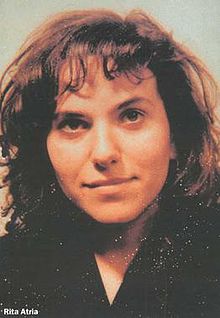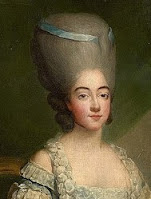Tragic teenager who broke Mafia code of omertà
Rita Atria, the girl from a Mafia family in southwest Sicily who famously went to the police after her father and brother were both killed by criminal rivals, was born on this day in 1974 in Partanna, in the province of Trapani.
Rita Atria defied her family by
talking to anti-Mafia investigators
She was just 11 years old when her father, Vito, ostensibly a shepherd but in reality a local Mafia boss, was shot dead by a hit man hired by a rival family.
The killing took place in 1985, nine days before her brother, Nicolò, was due to be married. He vowed to avenge his father’s death and spoke openly about knowing who was responsible.
He and his bride, Piera Aiella, a local girl, were both 18 at the time of their marriage. Piera, who had known Nicolò since he was 14, did not wish to marry him but Vito had thought she would make his son a suitable wife, and had made it clear to her that she had little choice in the matter. They had a child in 1988 and in 1991 moved to the nearby village of Montevago, where Nicolò set up a pizzeria.
The day he opened for business, in June, 1991, he and Piera invited a few friends to a modest celebration party. After the guests had left, Nicolò was clearing the tables when two hooded men armed with shotguns walked into the restaurant and shot him, continuing to pump bullets into his body even after he had fallen to the ground. Piera, who was standing only a few feet away with their three-year-old daughter, rushed to him but there was nothing she could do to save him and he died in her arms.
There were no witnesses, at least none who would come forward. The assumption was that Nicolò had been killed by a rival gang for speaking once too often about who he believed had murdered his father.
 |
| Paolo Borsellino became almost a father figure to Rita Atria |
It took her several months to find the courage, but in November 1991 she contacted the police, who put her in touch with the anti-Mafia magistrate, Paolo Borsellino. Alongside Giovanni Falcone, he had been the driving force behind the so-called Maxi Trial in the late 1980s, which had resulted in more than 300 Mafiosi going to jail.
Borsellino, a kindly man in his early 50s, listened sympathetically as Rita began to tell him what she knew. They developed a bond and Rita quickly came to regard Borsellino as almost a father figure. She and Piera, who also gave Borsellino her testimony, began to refer to him as ‘Uncle Paolo’.
Rita told Borsellino all she knew about the feuds between the Mafia families of Partanna, in which 30 people had died in just a few years. She gave him the names of the local Capi - the Mafia bosses - and those of the men who had killed her father and her brother. She also helped Borsellino with his investigation into the murder of the local deputy mayor.
She differed from the pentiti - the convicted Mafia members who supplied inside information about the organisation as a form of penitence for their crimes - in that she had never taken any role in her family's criminal activities. She was therefore described in court documents as a witness of justice.
As a result of her testimony, the police were able to make a string of arrests and over the following months more than 30 local Mafia figures were detained and convicted.
 |
| Piera Aiello, now an MP, also gave evidence to police |
Every effort had been made by Borsellino to conceal the identity of his sources but he knew Rita and Piera were now in grave danger and both had to be relocated away from Sicily. Rita was similarly given a new identity and installed in a safe house, an apartment on the seventh floor of a tower block on the outskirts of Rome. Piera moved initially to Rome too, although to a different address.
Rita lived almost the life of a hermit, seldom speaking to anyone for fear of giving herself away. Borsellino rang her regularly, but otherwise she spoke to no one.
In the meantime, in Sicily, the Mafia were plotting to restore their authority after the body blows left by the Maxi Trial and went about it ruthlessly. In May, 1992, Giovanni Falcone died when a bomb was detonated under a section of the motorway linking Palermo with the city’s airport at Punta Raisi. Two months later, Borsellino was killed by a car bomb near his mother's house in Palermo.
In Rome, Rita Atria read about the assassination the newspaper. A week later, having written a note to explain that without Borsellino she had no friends and felt there was no one left to protect her, she jumped from the seventh floor window. No one in the apartment block knew her and local police took two days to identify her body.
Her body was taken back to Sicily but without the intervention of anti-Mafia campaigners there would have been no funeral to mark her passing. Journalists who had taken an interest in the story were told by the local priest in Partanna that family members had requested that he did not say Mass for her. Ultimately a service was held for Rita, but the mourners largely consisted of prominent members of an anti-Mafia women’s group from Palermo, with just a smattering of local people.
Travel tip:
The Castello Grifeo in Partanna is one
of Sicily's best-preserved castles
Partanna, a hilltop town situated in the Valle del Belice agricultural area in southwest Sicily, about 60km (37 miles) inland from Marsala to the west and 40km (25 miles) from Sciacca to the southeast. It is best known for the Castello Grifeo, which dates back to the 11th century and is one of the best preserved castles on the west of the island. Its appearance is much as it was in the 14th century and it was in the possession of the Grifeo family until the late 19th century. Overlooking the Belice river, it dominated the town in medieval times, although after urban expansion it now presides over only a small corner of the town.
Travel tip:
A waterfront view of the fishing port of Trapani
on the west coast of Sicily
Partanna is in the province of Trapani, a fishing and ferry port notable for a curving harbour, where Peter of Aragon landed in 1282 to begin the Spanish occupation of Sicily. Well placed strategically to trade with Africa as well as the Italian mainland, Trapani was once the hub of a commercial network that stretched from Carthage in what is now Tunisia to Venice. Nowadays, the port is used by ferries serving Tunisia and the smaller islands, as well as other Italian ports. The older part of the town, on a promontory with the sea on either side, has some crumbling palaces and others that have been well restored, as well as a number of military fortifications and notable churches.
Also on this day:
1850: The birth of military general Luigi Cadorna
2006: The death of footballer Giacinto Facchetti
The Feast Day of Santa Rosalia, patron saint of Palermo









